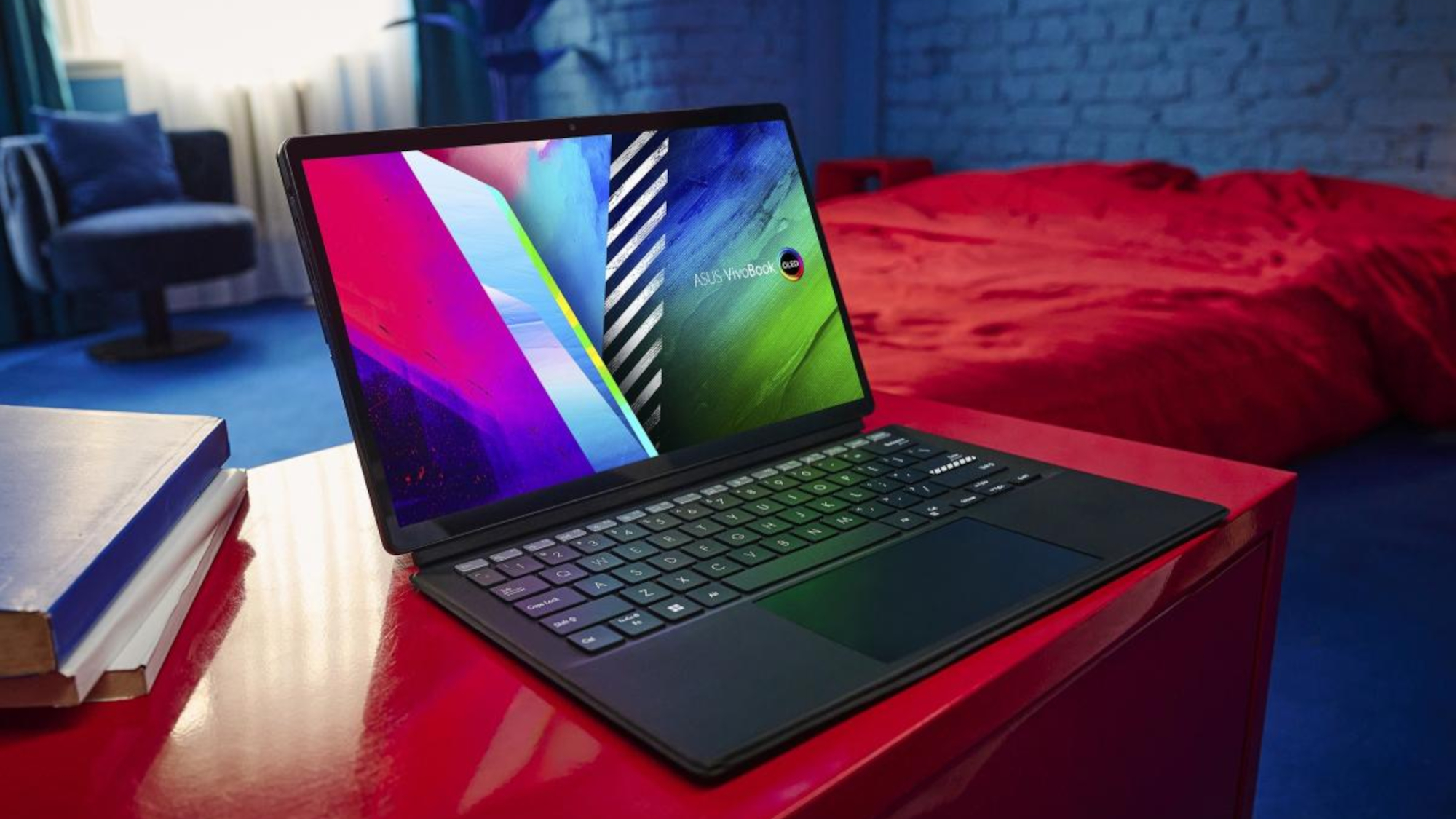Asus Vivobook 13 Slate is 'world’s first' OLED detachable 2-in-1 laptop — and it’s just $599
This 2-in-1 Windows 11 tablet could outshine the Surface Go 3 when it debuts in December

This December Asus plans to release the Vivobook 13 Slate OLED, a Windows 11 tablet with a starting price of $600 that includes a packed-in detachable keyboard and stylus. Asus is touting it as the first Windows 11 tablet with an OLED display, a feature Microsoft's own Surface Pro 8 and Surface Go 3 Windows 11 2-in-1s can't match.
Specifically, the Asus Vivobook 13 Slate OLED has a 13.3-inch 1080p OLED display with a 16:9 aspect ratio. It's advertised as capable of achieving up to 550 nits of peak brightness and covering 100% of the DCI-P3 color gamut. It has Dolby Vision and DisplayHDR True Black 500 certification and, according to Asus, the screen has 70% lower blue light levels than an LCD screen.
- The best 2-in-1 laptops in 2021
- Windows 11 problems and fixes — everything we know so far
- Plus: Steam phishing scam promises free Discord Nitro — don't fall for it
In terms of specs, the $600 entry-level model packs an Intel Pentium Silver N6000 system-on-a-chip processor, 4GB of memory and 128GB of eMMC flash memory storage. Other available configurations will have 8GB of memory and your choice of a 128GB or 256GB SSD for storage. Port-wise, the laptop has two USB-C ports, a microSD card reader, a headphone jack and an optional fingerprint sensor on the power button. Windows 11 comes packaged with the unit.
With a low-powered mobile chip like the Intel Pentium Silver N6000, this Vivobook likely won't match the power of the Surface Pro 8, which can't be bought with less than a speedy 11th Gen Intel Core i5 CPU.
Asus' new Vivobook 2-in-1 is far more comparable, power-wise, to the Surface Go 3 with its weaker mobile Intel Pentium Gold 6500Y or Intel Core i3-10100Y chips. That's a little concerning, because when we reviewed the Go 3 upgraded with the Intel Core i3 chip plus 8 GB of RAM and a 128 GB SSD, we found the performance underwhelming.
But while this Vivobook may not blow your socks off performance-wise, it's still shaping up to be a better deal than the Surface Go 3. While the Go 3 has a lower starting price of $399, that doesn't include a detachable keyboard or stylus. If you buy one of each from Microsoft alongside your Go 3, you can expect to pay upwards of $629. The Vivobook looks like a better deal by comparison, as you get a stylus and detachable keyboard for no extra charge, plus you get the added bonus of an OLED display.
The sound quality might be pretty good too, as the Vivobook 13 Slate OLED features a quad-speaker setup with Dolby Atmos, and Asus claims the speakers are 3.5 times louder than a standard amplifier. The tablet also has a 5-megapixel front camera, a 13-megapixel rear camera and noise-canceling mics. The unit comes with the detachable keyboard as well as a magnetic back cover with a kickstand. Its cover stand has a 170-degree hinge.
Get instant access to breaking news, the hottest reviews, great deals and helpful tips.
As mentioned, Asus’ Pen 2.0 stylus also comes in the box. Using Microsoft Pen Protocol 2.0, the included pen has up to 4,096 levels of pressure sensitivity. Four interchangeable pen tips mimic various types of real-world pencils. You can charge the pen through the aforementioned USB-C ports.
As with all new Windows 11 laptops, a free month of Xbox Game Pass Ultimate is included. The laptop’s Wi-Fi 6 capability will let you stream games from Xbox’s subscription service. Asus claims the device can run for over nine hours on a single charge, though we'll have to get one in for testing and review ourselves to see how true that proves under real-world conditions. The company also says you can recharge the battery to 60 percent capacity in a little over 30 minutes via USB-C.
Based on today’s announcement, the Asus Vivobook 13 OLED offers a lot to like in a 2-in-1 laptop. While its low-powered specs suggest it won't be great for gaming or other demanding tasks, it should be powerful enough to stand alongside Microsoft's Surface Go 3.
Plus, you won’t have to pay extra for a keyboard and stylus since both peripherals come standard — unlike the Surface Go 3. And of course, the OLED display promises deeper blacks, richer contrasts, and more vibrant colors than any non-OLED device. The relatively affordable $600 price for the entry-level model is icing on the cake.
- More: Asus ROG Flow X13 review

Tony is a computing writer at Tom’s Guide covering laptops, tablets, Windows, and iOS. During his off-hours, Tony enjoys reading comic books, playing video games, reading speculative fiction novels, and spending too much time on X/Twitter. His non-nerdy pursuits involve attending Hard Rock/Heavy Metal concerts and going to NYC bars with friends and colleagues. His work has appeared in publications such as Laptop Mag, PC Mag, and various independent gaming sites.
